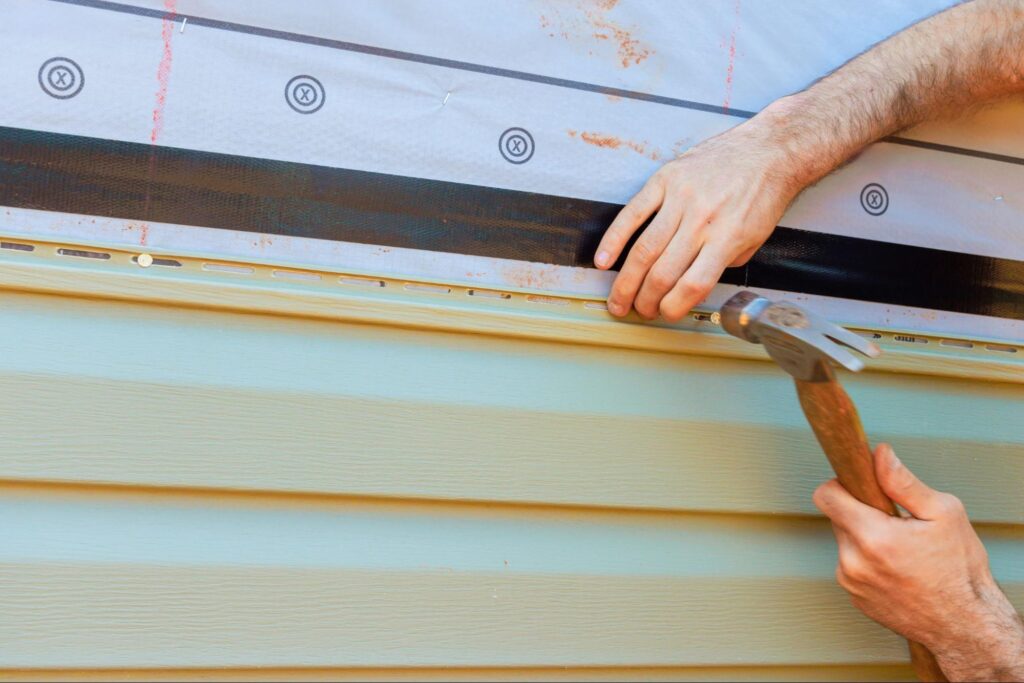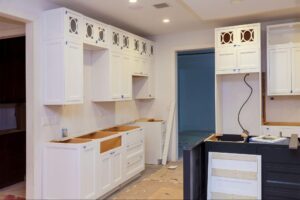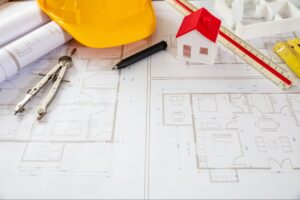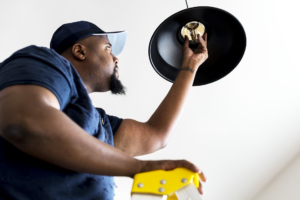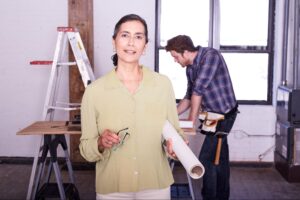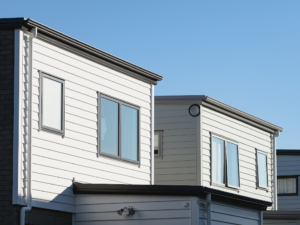Siding defines a home’s appearance and contributes to its long-term durability, energy efficiency, and overall value. It protects the structure from the elements while enhancing the property’s aesthetic appeal. Expert siding services provide access to materials to meet unique homeowner preferences. Exploring these options makes balancing style, functionality, and lasting performance easier.
Types of Siding for Modern Homes
Choosing the right siding can significantly impact a home’s appearance, durability, and overall performance. With numerous options available, knowing the key features and benefits of different siding types can make the decision process more manageable. Each siding material offers unique qualities and a range of possibilities to fit various styles, budgets, and needs. Familiarizing yourself with these options ensures a well-informed choice that balances aesthetics and functionality for your home.
Vinyl Siding
Vinyl siding is a popular choice for homeowners because of its affordability and low maintenance. Its lightweight design simplifies installation, reducing labor costs. Various textures and colors mimic the look of natural materials, such as wood, while maintaining weather resistance. This siding is resistant to fading, cracking, and pests, ensuring long-lasting appeal. Insulated versions enhance energy efficiency by reducing heating and cooling demands. Routine cleaning with water and mild detergent keeps it looking fresh for years.
Fiber Cement Siding
Fiber cement siding is known for its durability and ability to withstand harsh weather conditions. Its composition of cement, sand, and cellulose fibers offers resistance to fire, pests, and moisture. Homeowners can choose styles that mimic wood, stone, or stucco, giving it a versatile aesthetic. This siding requires minimal maintenance while providing an impressive lifespan of up to 50 years. The heavy weight of fiber cement adds strength to the exterior, protecting the structure. Installation costs may be higher, but the investment is worthwhile due to its longevity and reliability.
Wood Siding
Wood siding offers a classic, natural appearance that enhances a home’s charm. Cedar, redwood, and pine are popular options, featuring unique grain patterns and tones. Proper sealing and staining protect wood from rot, moisture, and pests, extending its lifespan. This siding type requires consistent maintenance to retain its beauty and functionality. Homeowners value its eco-friendliness, as wood is a renewable resource with biodegradable properties. Customization options, such as different cuts and finishes, make it a flexible choice for various architectural styles.
Metal Siding
Metal siding delivers a sleek, modern appearance while offering exceptional durability. Aluminum and steel are commonly used to resist rust, fire, and extreme weather. It reflects heat, making it energy-efficient in warmer climates, while its minimal maintenance needs appeal to busy homeowners. Modern finishes allow for various textures and colors, making it adaptable to different designs. The lifespan of metal siding often exceeds 40 years, providing long-term value. Its recyclable properties also make it an environmentally friendly option.
Brick Siding
Brick siding exudes timeless elegance while offering structural strength and durability. It provides excellent insulation, keeping interiors cool in summer and warm in winter. This siding is fire-resistant, low-maintenance, and highly durable, lasting for decades with minimal upkeep. Earthy tones and textures complement a range of architectural styles, adding curb appeal. While the initial installation cost is higher, the longevity and low maintenance often balance the expense over time. Its solid construction also reduces outside noise, enhancing indoor comfort.
Stone Veneer Siding
Stone veneer siding replicates the luxurious appearance of natural stone at a more affordable price. Lightweight and easier to install, it offers a cost-effective way to add sophistication to a home’s exterior. Options include natural stone or engineered veneer, with both delivering impressive aesthetics. When properly sealed and maintained, this siding resists fading, cracking, and moisture. It pairs well with various architectural styles, adding depth and texture to the design. Routine inspections ensure that its structural integrity remains intact over the years.
Stucco Siding
Stucco siding provides a unique texture and finish that works well with Mediterranean and contemporary designs. It is made from cement, sand, and lime, offering durability and energy efficiency. Stucco adapts well to warm and dry climates, as it helps regulate indoor temperatures. Homeowners can customize it with various colors and finishes, creating a tailored look for their home. While repairs may be necessary for cracks caused by foundation shifts, stucco is generally low-maintenance. Properly installed stucco siding lasts for decades, making it a reliable choice.
Composite Siding
Composite siding combines wood fibers, plastic, and cement to create a durable and versatile option. Its design mimics natural wood while offering superior resistance to moisture, pests, and weathering. This siding is lightweight, making installation more efficient and less costly. Homeowners value its low maintenance requirements, as periodic cleaning is sufficient to maintain its appearance. Recycled materials used in its production make it an eco-conscious choice. Composite siding provides a balance of affordability, longevity, and aesthetic appeal.
Assessing the Best Types of Siding For Your Needs
Each siding option offers unique strengths tailored to specific needs, making assessment a critical part of decision-making. Evaluating factors like durability, climate suitability, cost, and aesthetic appeal ensures that the chosen siding complements your home and lifestyle. Proper assessment involves balancing these elements to achieve functionality and visual impact. Knowing how to assess siding options empowers homeowners to make confident and informed choices.
Evaluate Durability and Longevity
Durability is a key factor when assessing siding options, as it determines how well the material withstands wear and tear. Materials like fiber cement and metal resist harsh weather, while brick and stone provide unmatched longevity. Consider the specific climate and potential exposure to extreme conditions when weighing durability. Longer-lasting siding typically justifies a higher upfront cost, as it minimizes repair and replacement expenses. Selecting a material that aligns with long-term maintenance capabilities ensures lasting performance.
Consider Climate Compatibility
The local climate plays a major role in determining which siding type will perform best. Stucco works well in warm, dry areas, while fiber cement and metal suit regions with extreme weather. Wood siding thrives in mild climates but requires sealing to protect against moisture in wetter areas. Cold climates benefit from insulated vinyl or fiber cement to enhance energy efficiency and protect against freezing temperatures. Aligning the siding choice with climate conditions ensures both functionality and longevity.
Weigh Aesthetic Appeal and Style
A siding’s appearance significantly impacts a home’s curb appeal, making style a priority in the assessment process. Options like wood and stone veneer enhance traditional homes, while metal and composite offer sleek finishes for modern designs. Fiber cement and vinyl provide versatile aesthetics, mimicking natural materials without sacrificing durability. Brick siding complements classic and rustic styles, adding timeless elegance to the exterior. Choosing a siding that matches the architectural design creates a cohesive and visually appealing result.
Assess Maintenance Requirements
Maintenance levels vary significantly among siding types, influencing long-term upkeep demands. Vinyl and composite siding require minimal care, while wood needs regular sealing and staining to maintain its appearance. Brick and stone siding demands little maintenance but benefits from occasional inspections to address minor issues. Fiber cement requires periodic repainting, making it manageable for those seeking moderate upkeep. Selecting siding with maintenance needs that fit your schedule ensures it remains in top condition over time.
Factor in Cost and Budget
The siding cost includes the initial purchase, installation, and long-term expenses. Vinyl and aluminum are affordable options with low maintenance costs, while brick and stone involve higher upfront investments but offer durability. Fiber cement balances affordability and longevity, making it a cost-effective choice for many homeowners. Assessing the total cost ensures the siding fits budget constraints while delivering long-term value. Weighing the initial investment against durability and maintenance helps achieve financial balance.
Estimated the Costs of Various Types of Siding
Cost often plays a significant role when deciding which siding is best for your home. Each siding type has a unique price range based on the material, durability, and installation requirements. Knowing the estimated costs of various siding options helps homeowners choose a solution that fits their budget while meeting their aesthetic and functional needs.
Vinyl Siding Costs
Vinyl siding costs between $3 and $8 per square foot, making it one of the most affordable options. Its lightweight design reduces installation expenses, and minimal maintenance improves its cost-effectiveness. Insulated versions are slightly more expensive but can save money in energy costs over time.
Fiber Cement Siding Costs
Fiber cement siding ranges from $5 to $15 per square foot, reflecting its durability and versatility. The material’s weight increases labor costs, but its long lifespan and low maintenance justify the higher upfront investment. Homeowners often choose it for its ability to mimic premium materials without the high price.
Wood Siding Costs
Wood siding prices fall between $5 and $12 per square foot, depending on the wood type. Cedar and redwood, known for their natural resistance to decay, are on the higher end of the scale. Maintenance costs, such as sealing and staining, can add to the overall expense over time.
Metal Siding Costs
Metal siding costs range from $7 to $15 per square foot, with aluminum and steel being the most common materials. Installation may cost more due to its weight and specialized labor requirements. Its durability and minimal maintenance make it a cost-effective long-term option.
Brick Siding Costs
Brick siding is priced between $8 and $18 per square foot, reflecting its durability and classic appeal. Professional installation adds to the initial expense, but its low maintenance requirements balance the cost. Its longevity ensures decades of use, making it a solid investment for homeowners.
Stone Veneer Siding Costs
Stone veneer siding costs from $10 to $20 per square foot, offering a luxurious look at a lower cost than natural stone. Its lightweight construction simplifies installation, reducing labor expenses. Proper maintenance ensures its durability, making it a visually appealing and practical choice.
Stucco Siding Costs
Depending on application complexity, stucco siding typically costs between $6 and $12 per square foot. The multi-layered installation process can increase labor expenses but ensures durability. Its ability to regulate indoor temperatures adds value over time, particularly in warmer climates.
Composite Siding Costs
Composite siding is priced between $4 and $10 per square foot, providing a budget-friendly yet durable option. Recycled materials contribute to its affordability without sacrificing quality. Its low maintenance and long lifespan make it a practical choice for homeowners seeking value.
Choosing the Best Types of Siding for Your Home
Exploring the various types of siding and associated costs is essential for making an informed decision. Each material offers distinct advantages, from affordability to long-term durability and aesthetic appeal. By assessing budget, climate suitability, and maintenance requirements, homeowners can confidently select the siding that aligns with their needs and enhances their property. Investing in the right siding protects your home and adds value and style that lasts for years.
Visit our Build All Construction Inc. blog for more expert insights and tips on home improvement.

